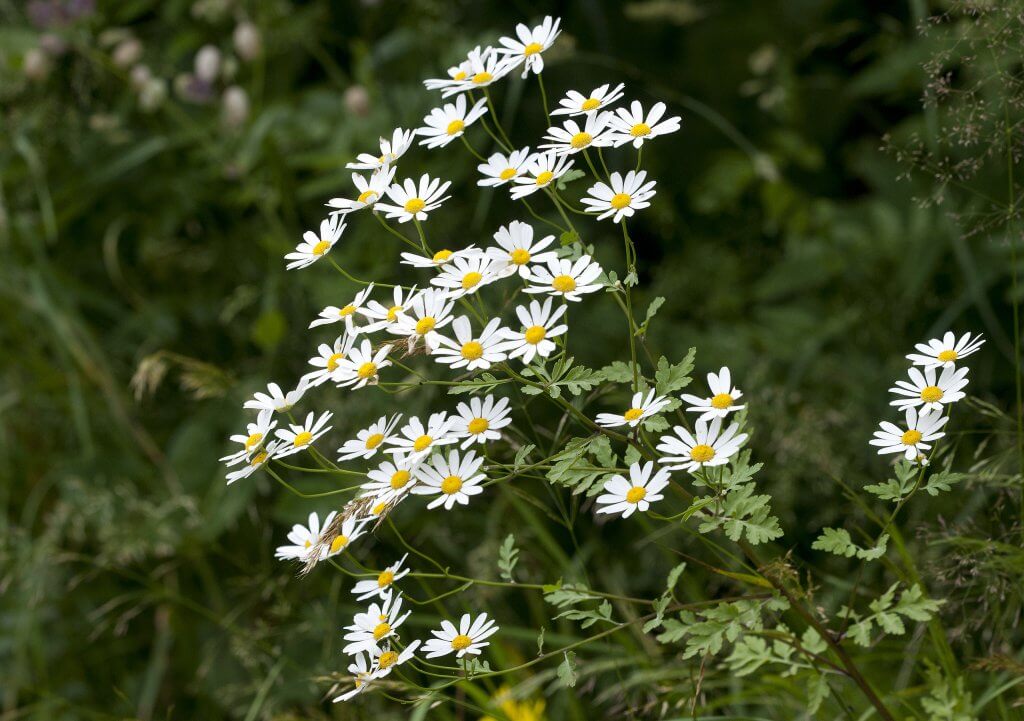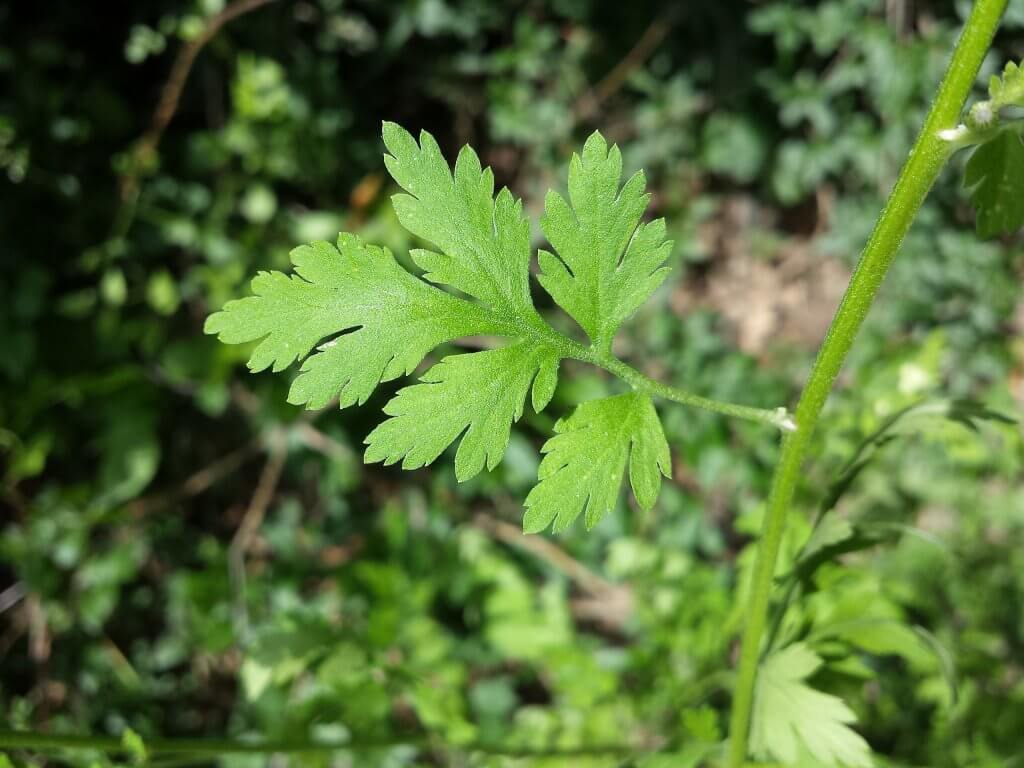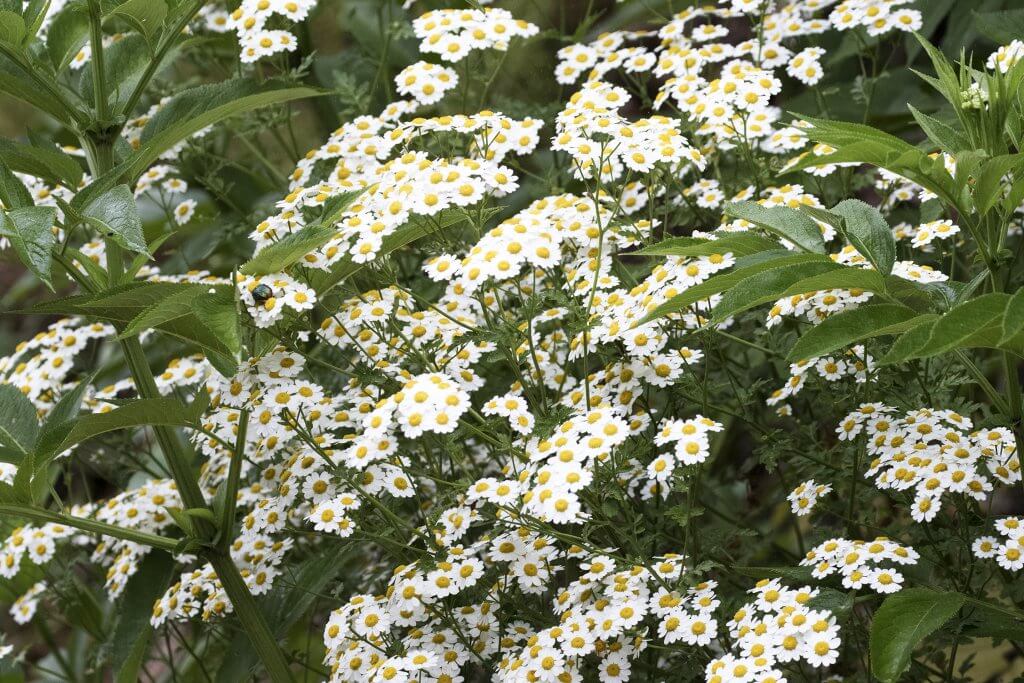Feverfew (Tanacetum parthenium) is a member of the daisy family, Asteraceae. The plant is a bushy, herbaceous perennial, and you will typically find it growing to about 70cm in height. It has button like yellow and white flowers that you may mistake for a daisy. The leaves have a yellow-green hue, which are soft and feathered and very highly scented.
Originally native to Europe and parts of Asia, you will now find it growing throughout the world. North America and Chile have particularly large populations. You will usually find it growing on grassy hillsides and mountains, forest edges and scrubland.
For centuries it has been used within herbal medicines and remedies for treating a number of conditions and illnesses. You may recognise feverfew by other names including, bachelor buttons, featherfew and midsummer daisy.

Cultivation and History of Feverfew
Feverfew grows rapidly and can self seed, causing many people to think of it as a weed. It grows extremely well in well drained soil and full sun. During Fall, cut the stems back until about 10cm remains above the ground. This will allow space for regrowth during the following year.
Start the seeds indoors during winter, or sow directly into your garden during late spring. You will begin to see seedlings after roughly 2 weeks.
Toxicity
You can safely consume feverfew and use it as a topical remedy. However you must process the leaves and flowers before using. Otherwise you may encounter some side effects. These include swelling of the mouth or headaches if you do not prepare the leaves correctly.
If you are pregnant or breast feeding, it is best to avoid using feverfew as a herbal remedy. This is because its effects on young infants have not been fully studied. If you are allergic to ragweed, chrysanthemums or other plants from this family, use caution when consuming feverfew. If you take blood thinners, you must avoid taking feverfew as it could react with the chemicals within and cause complications.
Uses
Culinary uses of Feverfew
Feverfew has a number of culinary uses, however its medicinal value is generally more popular. The leaves have a strong taste with hints of citrus. You can use it within particularly salty dishes, and also some savoury pastries. Due to its strong links with chamomile, you can also use the dried flowers of feverfew to create a herbal tea. It has a similar soothing and relaxing effect on the body.

Medicinal uses of Feverfew
Recent research into feverfew has concluded that it may help in soothing pains from migraines and headaches. Your sensitivity to light and nausea may also be reduced, which are typical migraine symptoms. Compounds and oils found within feverfew are also used within some skincare products. These compounds can soothe itching and inflamed skin. Rheumatoid arthritis and pruritus are two of the ailments feverfew may help to treat.
The ancient Greeks are considered one of the first cultures to have used feverfew for its healing properties. They used feverfew as an anti-inflammatory.

Did you know…
The name of feverfew has been influenced by its medicinal value. As it was used to treat a number of illnesses, including colds and fevers. The Latin word febrifugia, which translates as, ‘fever reducer’ is said to have inspired the name.
Conclusion
Feverfew is a beautifully ornamental plant which adds a hint of color and cheerfulness to a low border. The strongly scented flowers actual repel bees, so be sure not to plant feverfew next to plants that depend on pollination. Experiment with creating herbal teas with dried leaves and flowers or cutting flowers for a small arrangement of posies.
—————Written by Hannah Sweet
Hannah is a freelance writer and graphic designer from the UK. With a penchant for travelling, photography and all things botanical, she enjoys writing about a wealth of topics and issues, from conservation and slow living, to design and travel. Learn more about her writing and design services at www.sweetmeanders.co
Many of our readers find that subscribing to Eat The Planet is the best way to make sure they don't miss any of our valuable information about wild edibles.
See our privacy policy for more information about ads on this site







3 Responses
Hi,
I read your post about feverfew and noticed you had said it should be treated before using it. I was wondering how it should be treated?
I was wondering too
I think you dry the flowers and leaf before use… some oils of feverfew volatile when fresh, can eat flowers and leaves but try small amount first. Can be side effects for some people so best to take it easy